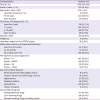1. Saag MS, Benson CA, Gandhi RT, Hoy JF, Landovitz RJ, Mugavero MJ, Sax PE, Smith DM, Thompson MA, Buchbinder SP, Del Rio C, Eron JJ Jr, Fätkenheuer G, Günthard HF, Molina JM, Jacobsen DM, Volberding PA. Antiretroviral drugs for treatment and prevention of HIV infection in adults: 2018 recommendations of the international antiviral society-USA panel. JAMA. 2018; 320:379–396.

3. Korean Society for AIDS. The 2015 clinical guidelines for the diagnosis and treatment of HIV/AIDS in HIV-infected Koreans. Infect Chemother. 2015; 47:205–211.
4. Walmsley SL, Antela A, Clumeck N, Duiculescu D, Eberhard A, Gutiérrez F, Hocqueloux L, Maggiolo F, Sandkovsky U, Granier C, Pappa K, Wynne B, Min S, Nichols G. SINGLE Investigators. Dolutegravir plus abacavir-lamivudine for the treatment of HIV-1 infection. N Engl J Med. 2013; 369:1807–1818.

5. Orrell C, Hagins DP, Belonosova E, Porteiro N, Walmsley S, Falcó V, Man CY, Aylott A, Buchanan AM, Wynne B, Vavro C, Aboud M, Smith KY. ARIA study team. Fixed-dose combination dolutegravir, abacavir, and lamivudine versus ritonavir-boosted atazanavir plus tenofovir disoproxil fumarate and emtricitabine in previously untreated women with HIV-1 infection (ARIA): week 48 results from a randomised, open-label, non-inferiority, phase 3b study. Lancet HIV. 2017; 4:e536–46.
6. Smith KY, Patel P, Fine D, Bellos N, Sloan L, Lackey P, Kumar PN, Sutherland-Phillips DH, Vavro C, Yau L, Wannamaker P, Shaefer MS. HEAT Study Team. Randomized, double-blind, placebo-matched, multicenter trial of abacavir/lamivudine or tenofovir/emtricitabine with lopinavir/ritonavir for initial HIV treatment. AIDS. 2009; 23:1547–1556.

11. Boettiger DC, Kerr S, Ditangco R, Merati TP, Pham TT, Chaiwarith R, Kiertiburanakul S, Li CK, Kumarasamy N, Vonthanak S, Lee C, Van Kinh N, Pujari S, Wong WW, Kamarulzaman A, Zhang F, Yunihastuti E, Choi JY, Oka S, Ng OT, Kantipong P, Mustafa M, Ratanasuwan W, Sohn A, Law M. Trends in first-line antiretroviral therapy in Asia: results from the TREAT Asia HIV observational database. PLoS One. 2014; 9:e106525.

12. Kim MJ, Kim SW, Chang HH, Kim Y, Jin S, Jung H, Park JH, Kim S, Lee JM. Comparison of antiretroviral regimens: adverse effects and tolerability failure that cause regimen switching. Infect Chemother. 2015; 47:231–238.

13. Ann H, Kim KH, Choi HY, Chang HH, Han SH, Kim KH, Lee JS, Kim YS, Park KH, Kim YK, Sohn JW, Yun NR, Lee CS, Choi YW, Lee YS, Kim SW. Safety and efficacy of ziagen (abacavir sulfate) in HIV-infected Korean patients. Infect Chemother. 2017; 49:205–212.

14. Rasmussen LD, Engsig FN, Christensen H, Gerstoft J, Kronborg G, Pedersen C, Obel N. Risk of cerebrovascular events in persons with and without HIV: a Danish nationwide population-based cohort study. AIDS. 2011; 25:1637–1646.
15. Choi AI, Vittinghoff E, Deeks SG, Weekley CC, Li Y, Shlipak MG. Cardiovascular risks associated with abacavir and tenofovir exposure in HIV-infected persons. AIDS. 2011; 25:1289–1298.

16. Cruciani M, Zanichelli V, Serpelloni G, Bosco O, Malena M, Mazzi R, Mengoli C, Parisi SG, Moyle G. Abacavir use and cardiovascular disease events: a meta-analysis of published and unpublished data. AIDS. 2011. 25:1993–2004.
17. Ding X, Andraca-Carrera E, Cooper C, Miele P, Kornegay C, Soukup M, Marcus KA. No association of abacavir use with myocardial infarction: findings of an FDA meta-analysis. J Acquir Immune Defic Syndr. 2012; 61:441–447.
18. Bannister WP, Friis-Møller N, Mocroft A, Viard JP, van Lunzen J, Kirk O, Gargalianos P, Bánhegyi D, Chiesi A, Lundgren JD. EuroSIDA Study Group. Incidence of abacavir hypersensitivity reactions in euroSIDA. Antivir Ther. 2008; 13:687–696.

19. Hetherington S, McGuirk S, Powell G, Cutrell A, Naderer O, Spreen B, Lafon S, Pearce G, Steel H. Hypersensitivity reactions during therapy with the nucleoside reverse transcriptase inhibitor abacavir. Clin Ther. 2001; 23:1603–1614.

20. Sun HY, Hung CC, Lin PH, Chang SF, Yang CY, Chang SY, Chang SC. Incidence of abacavir hypersensitivity and its relationship with HLA-B*5701 in HIV-infected patients in Taiwan. J Antimicrob Chemother. 2007; 60:599–604.

21. Park WB, Choe PG, Song KH, Lee S, Jang HC, Jeon JH, Park SW, Park MH, Oh MD, Choe KW. Should HLA-B*5701 screening be performed in every ethnic group before starting abacavir? Clin Infect Dis. 2009; 48:365–367.

22. To SW, Chen JH, Wong KH, Chan KC, Tsang OT, Yam WC. HLA-B*5701 genetic screening among HIV-1 infected patients in Hong Kong: is this a practical approach in Han-Chinese? Int J STD AIDS. 2013; 24:50–52.

23. Orkin C, Wang J, Bergin C, Molina JM, Lazzarin A, Cavassini M, Esser S, Gómez Sirvent JL, Pearce H. An epidemiologic study to determine the prevalence of the HLA-B*5701 allele among HIV-positive patients in Europe. Pharmacogenet Genomics. 2010; 20:307–314.











 PDF
PDF ePub
ePub Citation
Citation Print
Print





 XML Download
XML Download